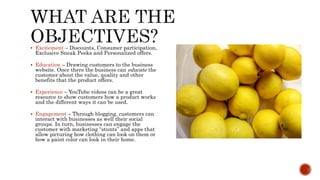Social media
- 1. How It Has Changed The Way We Do Business
- 2. Social Media has become the hottest commodity since sliced bread. Every minute of every hour millions of people are utilizing the benefits of having the world at their fingertips. Businesses are seeing opportunities to promote their wares across the nation and around the world. Every day is a new opportunity to meet new customers where they are. This Photo by Unknown Author is licensed under CC BY
- 3. Through Facebook customers are constantly hearing about products from their friends and families. They can ask questions before committing to spending their money. On the company website, customers can see the product, imagine how they could use the item, look for alternatives based on price, content or color. When they are ready they can order the item. YouTube offers videos about the products. Customers can experience how the item works. Giving them the chance to see if this particular item will meet their needs. They can determine what other alternative uses there are (getting more for their dollar), and they gain confidence knowing if more questions arise, they can come back to the videos.
- 4. Consumers no longer have to wait until someone can be on the other end of the phone to contact them. Emails and texts can be written anytime. Anywhere. Once the advertisement, blog, video or post is written, one click of a button and the material is scattered from one end of the earth to the other. The drawn out process of ink and paper communication is no longer sufficient as the sole means of advertisement. Digital communication is not a one way street. Customers are able to send emails, pictures and yes, videos to businesses. They can submit a complaint, compliment their customer services or even pitch their ideas for new products.
- 5. W Excitement – Discounts, Consumer participation, Exclusive Sneak Peeks and Personalized offers. Education – Drawing customers to the business website. Once there the business can educate the customer about the value, quality and other benefits that the product offers. Experience – YouTube videos can be a great resource to show customers how a product works and the different ways it can be used. Engagement – Through blogging, customers can interact with businesses as well their social groups. In turn, businesses can engage the customer with marketing “stunts” and apps that allow picturing how clothing can look on them or how a paint color can look in their home.
- 6. Core Goals – To Engage customers, encouraging them to spend time on the website, viewing and interacting with the content. Contextual Elements – Targeted towards the market the business wants to reach, font, color, animation and navigation are all part of the Contextual Elements Content – Keeping the information relevant and exciting but not necessarily always about selling products. This Photo by Unknown Author is licensed under CC BY
- 7. Community – Interaction, socialization, sharing information are great for building a community. Communication – Live chat, email, brick and mortar address, and telephone. Businesses want to provide multiple communication portals. Commerce – Websites and the higher conversion rates they offer, are the preferred method of making purchases. Connection – Call-to-action buttons encourage customers to dive further into the website. Checking out other pages, find other information about the company and hopefully make a purchase are the goals of connection. This Photo by Unknown Author is licensed under CC BY
- 8. Listen. Sometimes the feedback might be what they want to hear. Hopefully, great things are being said about the company. Analyze. Businesses can hire companies to provide analytic tools to monitor what is being said about their company and who is saying it. Hits, or clicks, a page generates as well as how many unique visitors and page views the website is getting is important. Do. Implementation of the data received is critical. This Photo by Unknown Author is licensed under CC BY-SA
- 9. Someone with clout, someone who is famous and is admired by millions. Someone with good looks but isn’t necessarily famous. Someone who speaks truthfully about the product or business. Someone whose voice carries a lot of weight. All of these qualifications describe who would be a great influencer.
- 10. Social Media is constantly evolving. Digital forms of advertising include Facebook, YouTube and blogs. Social Media and websites offer instant gratification, immediate disbursement around the world. Excitement, Education, Experiences and Engagement are the objectives of digital marketing. Website building includes building a community, offering vessels of communication and connection with the community. Listening, Analyzing and Doing are the responsibility of the business to take advantage of Digital Marketing. It does not hurt to have a famous person advocating for your business.









